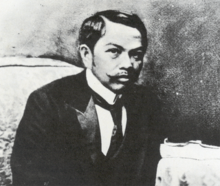This article includes a list of general references, but it lacks sufficient corresponding inline citations. (December 2014) |
Juan Luna | |
|---|---|
 Juan Luna c. 1899 | |
| Born | Juan Novicio Luna October 25, 1857[a] |
| Died | December 7, 1899 (aged 42) |
| Known for | Painting, drawing, sculpting |
| Notable work |
in museums: |
| Movement | Academic Art ; Romanticism, Neoclassicism, Realism, |
| Spouse | |
| Family | Antonio Luna (brother) Joaquin Luna (brother) |
Juan Luna de San Pedro y Novicio Ancheta (Spanish: [ˈxwan ˈluna], Tagalog: [hwɐn ˈluna]; October 25, 1857 – December 7, 1899) was a Filipino painter, sculptor and a political activist of the Philippine Revolution during the late 19th century. He became one of the first recognized Philippine artists.
His winning of the gold medal in the 1884 Madrid Exposition of Fine Arts, along with the silver win of fellow Filipino painter Félix Resurrección Hidalgo, prompted a celebration which was a significant highlight in the memoirs of members of the Propaganda Movement, with the fellow Ilustrados toasting the two painters' good health and the brotherhood between Spain and the Philippines.
Well regarded for work done in the manner of European academies of his time, Luna painted literary and historical scenes, some with an underscore of political commentary. His allegorical works were inspired by classical balance, and often showed figures in theatrical poses.
- ^ "NHCP corrects Juan Luna's birthdate to October 25, 1857". GMA News Online. October 10, 2023. Retrieved October 10, 2023.
- ^ "Historical commission changes Juan Luna's birth date". CNN Philippines. October 9, 2023. Archived from the original on October 10, 2023. Retrieved October 10, 2023.
Cite error: There are <ref group=lower-alpha> tags or {{efn}} templates on this page, but the references will not show without a {{reflist|group=lower-alpha}} template or {{notelist}} template (see the help page).